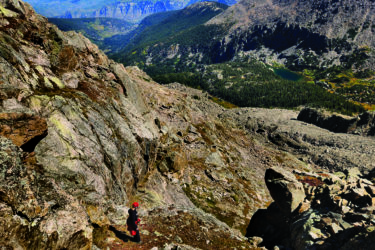The Local newsletter is your free, daily guide to life in Colorado. For locals, by locals.
September is upon us, and all around the Centennial State, love is in the air. Tarantulas are getting frisky in the Southern Colorado town of La Junta. West of Grand Junction, bighorn sheep in Colorado National Monument are especially, er, horny. And in Estes Park, the roughly 700 elk that call Rocky Mountain National Park home are on the hunt for some action.
Known as the “rut,” the elk mating season lasts from early September to mid-October. Males, or bulls, seek to win the attention of female cows (and defend those already in their harem) by showing their fitness for breeding. In rare instances, two bulls will charge at each other and even spar with their antlers. More often, however, they elicit a high-pitched squeal that fades into a few deep-bellied grunts. This bugling process, which often happens at dawn and dusk, demonstrates to eligible females within a couple of miles that he’s a willing suitor.

“The bugle itself is otherworldly,” says Katie Colson, field institute coordinator and interpretive hike and tour leader for Rocky Mountain National Park’s nonprofit partner, the Rocky Mountain Conservancy. Between the sound, the bulls’ impressive antlers, and the steam that often rises from their mouths and nostrils on cold mornings and evenings, “they really put on a show,” Colson adds.
It’s incredible to witness—if you do so safely. That involves maintaining a distance of at least 75 feet from the elk. Colson suggests using the rule of thumb to ensure you’re observing from a safe distance. “If you put your arm straight out and give a thumbs up, you should be able to cover the animal,” Colson says. “If you can still see the animal with your arm out and thumb up, then you’re too close.”

Pay attention to annual closures in Rocky Mountain National Park’s meadows, which restrict all travel (both on foot and on horseback) beyond established roads and trails. “The herds can move at any moment,” Colson says, noting that they might be protective of females or spooked by people. “All of a sudden they could be running straight toward you.”
But if you want to watch this wild version of the Bachelor in person, here are seven ways to do so without ruining their rizz.
1. Take a hike in Rocky Mountain National Park.
Lace up your boots and set out on a moderate hike 2.3 miles one-way to Cub Lake. Just steps from the trailhead, cross the Big Thompson River before continuing south to trace the western barrier of Moraine Park—a hot spot for the guests of honor. The first half-mile of the trail serves up your best elk-spotting opportunity, though there’s potential to hear their eerie bugling as the trail bends west toward Cub Lake.
2. Attend a ranger talk.
Many ranger-led discussions that take place during autumn will mention the elk rut, but for an ungulate-specific talk, attend the Elk Migration Chat at the Beaver Meadows Visitor Center, which takes place daily at 10:30 a.m. through October 13. You’ll hear about the mating and migration habits of the specific herds that call the park home, plus, you can pick the park ranger’s brain about any other elk inquiries you might have.
3. Join an expert-led driving tour.
Numerous companies throughout the Estes Valley provide guided vehicle excursions. One great option: The Rocky Mountain Conservancy’s Scenic Elk Ecology Tour ($27.35 per person), which takes place every Thursday, Friday, and Saturday at 3:30 p.m. through October 5. Guests meet at the Fall River Visitor Center, hop onto a 14-passenger minibus, and then drive into Rocky Mountain National Park to observe the herds at their favorite haunts. Over the course of 3.5 hours, your professional educational guide explains elk ecology, interprets their behavior, and passes around elk antlers, hides, and other artifacts. Fellow tour operator Explore Estes has rut-focused rides as well.
4. Dine at Ember Restaurant & Bar.
At the Ember Restaurant & Bar, located on the northeastern edge of Lake Estes, there’s always a chance to see an osprey or bald eagle soaring above the water in search of a snack. But come fall, it’s a prime place to watch bulls hunt for love. Be sure to request a window seat, and while you peruse the modern American favorites on the menu, keep one eye on the lakeside lawn where elk may gather to strut their stuff. We’ll let you decide if savoring a lingonberry demi-glace-covered elk tenderloin while watching elk is unnecessarily meta or just delicious.
5. Enjoy a scenic drive.

If you want to be the one behind the wheel, we recommend cruising Colorado’s first official scenic drive to score an eyeful of elk. Spend a restful night at stylish staycation spot Trailborn, conveniently located at the Peak to Peak Scenic Byway’s northernmost point, to get a dawn’s-early-light start to your self-guided safari (and therefore have the best chance of elk spotting).
From the hotel, turn southeast onto South St. Vrain Avenue and head 6.5 miles to Lily Lake. Bulls and their harems like to congregate here during the fall rut, which means you get a fantastic photo-op featuring elk and a mountain lake in the foreground with Mt. Meeker and Longs Peak in the background. A drive along Rocky Mountain National Park’s Trail Ridge Road, the highest continuous paved road in the United States, provides additional opportunities to see and hear the rut from the safety of your car.
Whichever road you take, keep in mind that (of course) traffic laws still apply during the elk rut. “It can be really enticing just to stop where you’re at when there’s a herd around,” Colson says, “but you need to find a pull-off to safely stop your vehicle.”
6. Give ’em your best bugle at Elk Fest.
Curious to hear how your ungulate impersonation stacks up? Partake in the elk bugling contest, which is a longstanding (and yes, loud) tradition at Estes Park’s annual Elk Fest (Sept. 27–28). This wapiti party also includes educational elk talks, native dances and storytelling, a slew of booths from local vendors, and live raptor demonstrations.
7. Go behind the lens.
Did you even see an elk if you don’t post it to the ’gram? Get expert tips on snapping the perfect wildlife shot when you take a photography tour with Yellow Wood Guiding. The outfitter offers a range of tour options, so whether you’re carrying a Canon EOS or you just learned about your iPhone’s portrait mode, you’ll leave with stills sure to earn you some likes.
Photogs who are more serious about their craft should look into the Antlers & Aspen Rocky Mountain NP tour (starting at $2,650) from Wildside Nature Tours. This four-day excursion for up to eight people includes instruction by former North American Nature Photography Association president Dawn Wilson and Beyond the Wild podcast host Ron Hayes. Expect to wake before dawn to capture the best images—including the elk’s famous “bugle breath”—and stay up past your bedtime to score snapshots of the national park’s ink-black skies (the workshop coincides with the new moon).
Read More: First-Timer’s Guide: Estes Park








